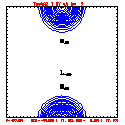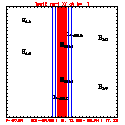Updated Thu.
May 9
Links to pages for program 6:
Description
- Problem: 3-D nonlinear quasi-compressible
flow.
- Method: Directionally split piecewise linear advection, using Strang splitting.
- Handout for programs 5+6: PDF.
- Submit everything on Moodle.
- Comments -
- make sure your Makefile
has "$(OPTIONS)" after "-c" in the settings at
the bottom (C: ".c.o"; Fortran: "%.o").
- official problem settings are not yet posted.
- Grading:
- 45% of the grade is based on running
the 3d low-resolution problem
w/Lax-Wendroff w/correct solutions.
+5=50% of the grade for running the 3d low-resolution problem w/Piecewise-Linear w/correct solutions.
(If you successfully run the high-resolution case, you don't have to also run/submit the low-resolution case) - +25%=75% of the grade is based on
the 3d high-resolution problem
w/Piecewise Linear w/correct
solutions.
(If you successfully run the high-resolution case, you don't have to also run/submit the low-resolution case) - 15% of the grade is for 3d visualization (a single
plot during the run, beyond
T=0!) with VisIt or Paraview
(3d 'wireframe' plots w/plot3d are not sufficient for this) (this cannot be the initial condition!)
- 5% of the grade is for running in the system batch
queue (effectively required for the full-sized
problem)
- 5% of the grade is for a reasonable attempt at parallelization of your code.
Links to pages for program 6:
* Program 6 settings -
to run the official low-res/high-res problem
* Running on Stampede2 * Visualization * Using program plot3d * Initial conditions * Boundary conditions
* Timing of program #6 * Running in parallel and/or batch * FAQ / questions + answers
* Running on Stampede2 * Visualization * Using program plot3d * Initial conditions * Boundary conditions
* Timing of program #6 * Running in parallel and/or batch * FAQ / questions + answers
Test case results for Program #6
Use these test cases (run at 500 meters) to check your code for the full problem (at 50 meters) for various processes.Click on a small image below to jump to a test page.




